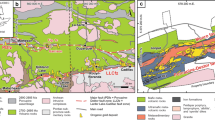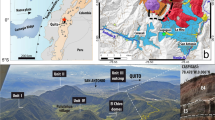Abstract
“Ptygmatic folds” are herein termedptygmatic features orptygmas because folding appears to have had no role in their formation. The term ptygma is defined, by description, on the basis of close examination of numerous occurrences. An hypothesis, termed development in a passive host during differential anatexis, is proposed to account for formation of at least many ptygmas. Under this hypothesis, the characteristic features of a ptygma are formed during development of the ptygma (typically quartz plus one or more feldspars) within a passive host (typically a biotite-feldspar gneiss). The development is dependent upon differ ential melting of the host, local migration of solutions then formed, reactions between the migrating material and the remainder of the rock, and subsequent consolidation. The migration is into zones of real or potential low energy and/or pressure and results in formation of ectects and addition of material to certain relict sedimentary laminae, veinlets, and dikelets. At the time migration starts, the migrating material and the remainder of the rock have unequal chemical energies. So long as these inequalities persist, the interface between the two members of the system will tend to change position and shape and the migrating material will thereby develop the characteristic features of ptygmas.
It appears that conditions necessary to form ptygmas by the suggested means would be such that any spatially associated material of granitic composition would go through a magmatic stage.
Similar content being viewed by others
References
Barth, T. F. W.: Zonal structure in feldspars of crystalline schists. Tercera Reunion Int. Sobre React. de los sóolidos, Madrid, Sec.3, 263–371 (1956).
Bowex, N. L., andO. F. Tuttle: The system NaAlSi308-KalSi308-H20. J. Geology58, 489–511 (1950).
Burke, J. E.: The migration of grain boundaries: in “Atom Movements”. Amer. Soc. Metals, 204–232 (1951).
De Sitter, L. U.: Structural geology, p. 552. New York: McGraw-Hill 1956.
Gilluly, James: The Ajo mining district, Arizona. U.S. Geol. Survey209, 112 (1946).
Goransox, R. W.: Some notes on the melting of granite. Amer. J. Sci., V. Ser.23, 227–236 (1932).
Odell, N. E.: The petrography of the Franz Joseph Fjord region, northeast Greenland, in relation to its structure: a study in regional metamorphism. Trans. Roy. Soc. Edinburgh 221–246 (1944).
Scheumaxx, K. H.: Metatexis and metablastesis. Mineral. Petrogr. Mitt.48, 402–412 (1936)
Sederholm, J. J.: Om granit ochgneis. Bull. Comm. Geol. Finlande23, 110 (1907).
Tuttle, O. F.: Origin of the contrasting mineralogy of extrusive and plutonic salic rocks. J. Geology60, 107–124 (1952).
Origin of the contrasting mineralogy of extrusive and plutonic salic rocks: a reply. J. Geology61, 278–280 (1953).
Wegmann, E.: Zur Deutung der Migmatite. Geol. Rdsch.26, 305–350 (1935).
Author information
Authors and Affiliations
Additional information
on leave from Department of Geological Sciences Virginia Polytechnic Institute, Blacksburg (Virginia) U.S.A
Rights and permissions
About this article
Cite this article
Dietrich, R.V. Development of ptygmatic features within a passive host during partial anatexis. Beitr Mineral u Petrogr 6, 357–365 (1959). https://doi.org/10.1007/BF01206337
Received:
Issue Date:
DOI: https://doi.org/10.1007/BF01206337




